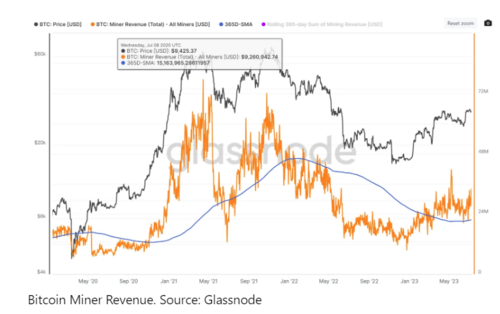
.png)
British multinational bank Standard Chartered has boosted its Bitcoin price forecast to $120,000 by the end of 2024—a 300% leap from where it is today.
In a report viewed by Reuters, the bank predicted Bitcoin’s rise will be driven largely by miners hoarding their coins and cutting off additions to Bitcoin’s circulating supply.
“Increased miner profitability per BTC (bitcoin) mined means they can sell less while maintaining cash inflows, reducing net BTC supply and pushing BTC prices higher," wrote Geoff Kendrick, one of Standard Chartered’s top FX analysts, in the report.
Bitcoin is up 82% year to date, from $16,600 on January 1 to $30,280 at writing time. Since miners are rewarded with a fixed number of BTC (6.25) per block, such bullish price momentum has helped boost the industry’s revenue since the start of the year, reversing negative momentum amid declining revenue in 2022.

Bitcoin Miner Revenue. Source: Glassnode
The opposite trend was visible in June of 2022, when BTC's falling price forced major miners like Core Scientific and Riot to dump the vast majority of their coins on the market, only contributing to Bitcoin’s free fall to under $18,000.
Today, miners have good reason to believe Bitcoin is back in an early upswing. Data from on-chain analytics firm Glassnode shows that a large share of BTC has been moving hands from short-term holders to strong hands over the past few months, which is “ a primary component of all prior Bitcoin bull markets.” Long-term holders are entities that haven’t moved their coins for over 155 days and are generally less likely to be active (ex. be sold) in the near term.
Moreover, Bitcoin “Shrimps”—small entities with less than 1 BTC—appear to be stacking sats harder than at any time since the peak of the late 2017 bull market. This cohort alone is sucking up more coins each month than miners can produce in their totality.
According to Kendrick’s estimates, miners are still selling 100% of their newly mined coins to cover costs. However, if Bitcoin’s price rises to $50,000 by the end of the year, this share of sold coins might reduce to just 20-30%, reducing circulating supply and creating a bullish feedback loop.
“It is the equivalent of miners reducing the amount of bitcoins they sell per day to just 180-270 from 900 currently,” he said. “Over a year, that would reduce miner selling from 328,500 to a range of 65,700-98,550 – a reduction in net BTC supply of roughly 250,000 bitcoins a year."
Markets are optimistic that Bitcoin could surge higher this year if a Bitcoin spot ETF is approved in the United States. BlackRock, which filed for one such product last month, boasts a regulatory approval record on such products of 575:1.
